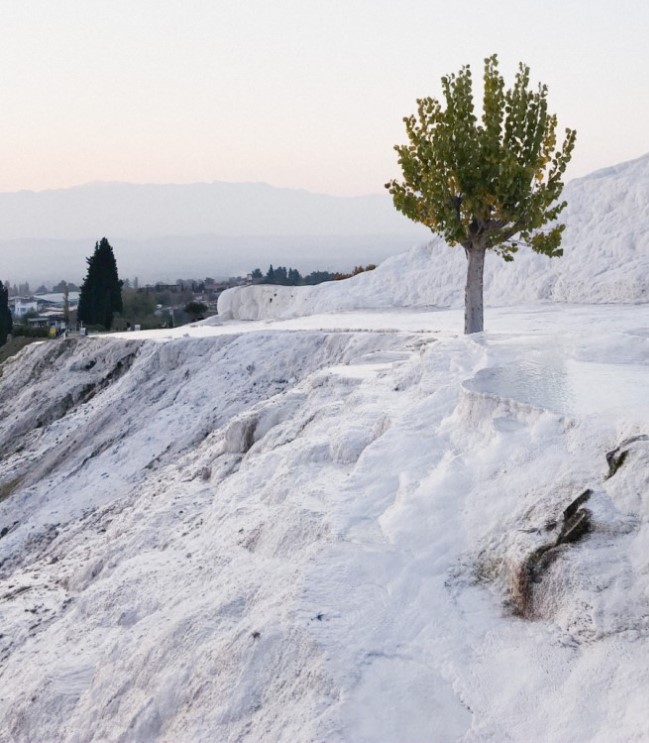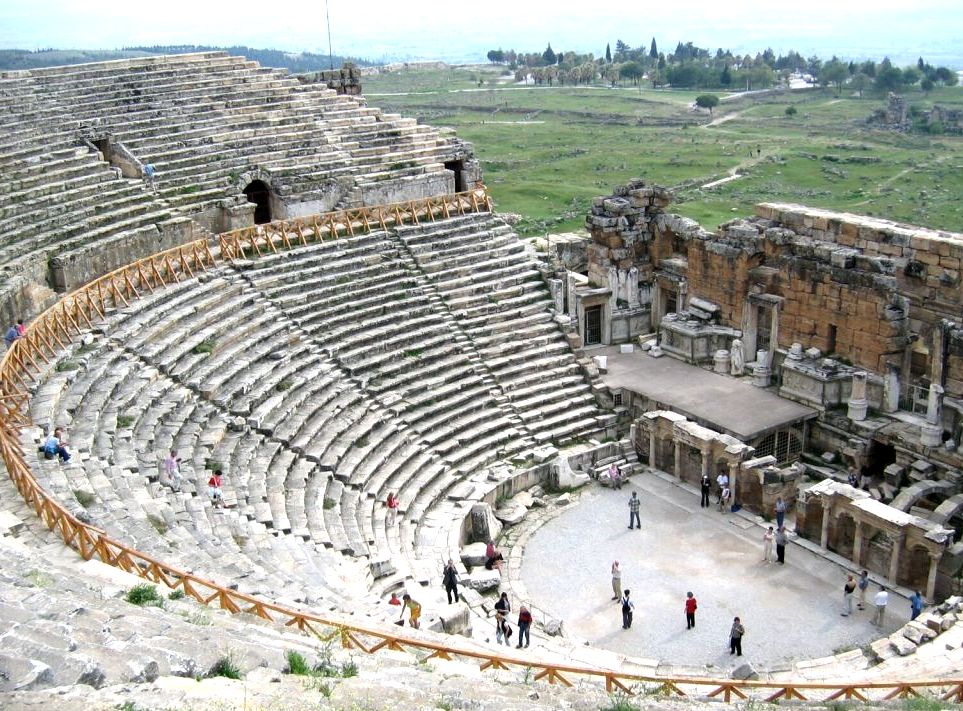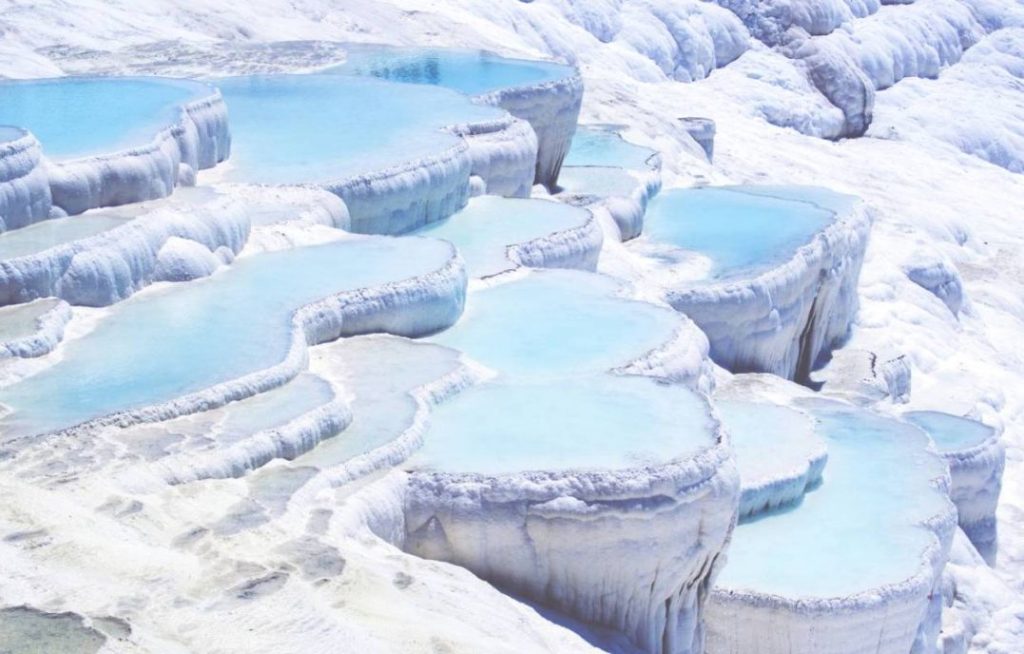Pamukkale City
Pamukkale city name means ‘Cotton Castle in Turkish, you will understand why when you see this magical natural masterpiece. Forming over hundreds of thousands of years, the travertine pools cascade down the hillside, and have been visited by many famous people. The natural water here is considered to possess healing qualities, visitors can enter the pools. It is now listed as a World Heritage Site.
Since it is only about 3.5 hours away from our Selcuk hotel by bus. There are many people doing day trips to Pamukkale and the travel agencies are organizing daily trips to this ancient beauty. If you’re interested in having a day trip, we can help you organize it easily.
Pamukkale Travertines
Travertines are rocks that have collapsed as a result of a chemical reaction. Since Pamukkale is a big earthquake zone, it has quite a lot of thermal water resources. When thermal water combines with air, we see the appearance of cotton because of calcium carbonate. Pamukkale Travertines are in the ancient city of Hierapolis. So if you want to see the travertines, you have to enter the ancient city of Hierapolis. Also, there is the Hierapolis antique pool on the upper part of the travertines. You have to pay an extra 32 Turkish Liras per person to enter the Hierapolis ancient pool. You can take a walk around the pool and take pictures without going into the pool.

History of Pamukkale
Pamukkale is a district of Denizli city. Pamukkale has both natural beauties such as travertines and historical places such as Hierapolis & Laodicea’s ancient cities. Today, many tourists visit Pamukkale travertines and thermal springs for health purposes. These natural resources have been the reason for the establishment of many important ancient cities here in history. Pamukkale takes its name from this cotton image of the travertines. The word “Pamuk” means cotton. The history of Pamukkale started in the Hellenistic period in the second century. In the 2nd century BC, Pergamon King Eumenes II established a city in Pamukkale. As the centuries passed, different kings here developed this city. Other kings even set different towns such as Laodicea. So, Roman emperors had this ancient city for a long time. In the 11th century, Turks captured this ancient city. Pamukkale has come to this day in this way.
What should we see in Pamukkale?
One of the most significant historical places of Pamukkale is the ancient city of Hierapolis. King Eumenes II founded the ancient city of Hierapolis in the 2nd century. The reason why the city’s name is Hierapolis is Hiera, wife of Telephus in Greek mythology. Also, Hierapolis has many hot underground water sources around it. Therefore, geographically this region is an earthquake zone. Due to earthquakes, there is no trace left from the Hellenistic period of Hierapolis. The artifacts we see today are generally those made after 60 BC. One of the biggest symbols of Hierapolis ancient city is the great old theater. Hierapolis Ancient Theater is 1800 years old. It has been preserved together with all the architectural materials of the Hierapolis Antique Theater. With this feature, it is the only example among the Roman period Anatolian Theaters in the Mediterranean. Hierapolis Antique Theater has a capacity of 10,000 people.
Also, there is the St. Philippe Martyrion Church in the ancient city of Hierapolis. Although the date of construction of the St. Philippe Martyrion Church is uncertain, historians estimate it to be the fifth century A.D. Saint Philippe came to the Pamukkale region to spread Christianity. Pagan people killed Saint Philippe in this area. That’s why people needed a church built to commemorate Saint Philippe here. This church has an important place as one of the seven important churches in Anatolia. Since the roof of the church is wooden, it does not have any roof today.
Hierapolis Ancient City
Pamukkale travertines and the ancient city of Hierapolis are just next to each other. Hierapolis, the “Sacred City,” is at present-day Pamukkale in south-central Turkey. Perched above the travertines of Pamukkale sit the Ancient ruined city of Hierapolis. Listed as a UNESCO World Heritage Site, there is not a lot known about its origin. Pamukkale’s hot springs gave this city life, as people had been curing their ailments in the ‘spa’ since the 2nd Century BC. Situated onsite is a large Necropolis filled with Sarcophagi, including that os the great Marcus Aurelius Ammianos. More info on Hierapolis.
Moreover, the bath of Hierapolis Ancient City is now a museum. In the Hierapolis Archeology Museum, you can see valuable historical artifacts. This museum has not only the works of Hierapolis Ancient City. Many artifacts belong to ancient cities such as Laodikeia, Tripolis, Colossai, and Attuda in Hierapolis Archeology Museum.

History of Laodicea Ancient City
Another important ancient city is the ancient city of Laodicea. Laodicea is close to the ancient city of Hierapolis. The ancient city of Laodicea is interesting with its unique ancient theater and magnificent columns. Many archaeologists are continuing excavations in the ancient city of Laodicea. That’s why we can see more archaeological artifacts in the ancient city of Laodicea in the future.
You must have a Museum Pass to enter ancient cities such as Hierapolis and Laodicea on your visit. The museum pass fee for Turkish citizens is 60 Turkish Liras. There are two different music card options for foreign citizens. The first option to buy Museum pass in Turkey. Museum Pass with Turkey for 15 days you can visit all the museums in Turkey. Museum Pass Turkey’s fee is 550 Turkish Liras. The second option is to buy the Museum Pass Mediterranean. You can visit all museums in Antalya, Mersin, Adana and Denizli cities for seven days with Museum Pass Mediterranean. Museum Pass Mediterranean is a more economical option because the Museum Pass Mediterranean’s price is 325 Turkish lira.
How can we go to Pamukkale?
There are many different options for traveling to Pamukkale. These options vary depending on how you arrive in Denizli city. First, the plane trip takes a little longer to travel to city. Denizli Çardak Airport is quite far from Pamukkale. If you are going to Pamukkale from the airport, you must first go to the city center. After taking a bus to the city center, you will have to take another bus from the city center. It is possible to go to Pamukkale on a long journey by taking two separate buses. Apart from that, the Pamukkale bus terminal is very close to ancient cities and natural beauties to visit. If you come to Denizli by bus, you will get off at the Pamukkale bus terminal. You can go to ancient cities such as Hierapolis in 15-20 minutes by taking regular minibusses from the Pamukkale bus terminal.
Another way to come to Denizli is by train. You can come from Izmir by train. It is near the Pamukkale bus terminal at Denizli Train Station. Therefore, after getting off the train station, you can go to the Pamukkale bus terminal. At Pamukkale bus terminal, you can travel anywhere you want with the same method. Taxi is also a taxi service for travel in Pamukkale. You can use a cab after arriving at the Pamukkale bus terminal. Pamukkale bus terminal is very close to places to visit. In this way, you do not need to pay a high fee for a taxi. Finally, of course, you can travel to Pamukkale by personal vehicle. Even if you do not have a private car, you can find many car rental companies in Denizli province. You can use google maps to complete your trip in Pamukkale with your vehicle.


Pingback: Pamukkale & Hierapolis Ancient City Tour - Ephesus Centrum Selcuk Hotel